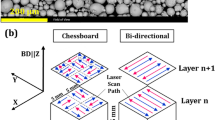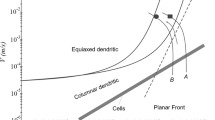Abstract
In-situ compact tension tests on binary lamellar titanium aluminide (TiAl) possessing the colony ``polycrystalline'' microstructure illustrate a range of damage phenomena and toughening mechanisms including crack nucleation across colony boundaries, plastic deformation of bridging ligaments, and multiple cracking within colonies. Here, the effects of relative lamellae misorientation and offsets between neighboring colonies on crack growth are investigated computationally through an idealized microstructure of multiple colonies. Within each colony, the brittle Ti3Al lamellae are represented as parallel planes of comparatively low toughness embedded in a matrix of ductile TiAl lamellae that are collectively modeled as an elastic-viscoplastic solid with higher fracture toughness. Plane strain calculations of crack growth are carried out on a compact tension geometry. The calculations are in good qualitative agreement with the in-situ observations, capturing many features of crack growth such as multiple microcrack nucleation and plastic deformation of residual ligaments. Experiments and numerical analyses show that changes in lamellar orientation and alignment across a colony boundary can contribute significantly to the fracture resistance. The numerical results demonstrate that the fracture resistance of these alloys is determined by an intricate interplay between matrix ductility, Ti3Al and TiAl fracture toughnesses, and colony boundary toughness. This suggests the possibility of computationally-guided material optimization through microstructural control of these material properties.
Similar content being viewed by others
References
Albert, D.E. and Gray, G.T. (1997). Mechanical and microstructural response of Ti-24Al-11Nb as a function of temperature and strain rate. Acta Materialia 45, 343–356.
Appel, F., Christoph, U. and Wagner, R. (1995). An electron-microscope study of deformation and crackpropagation in α2 + γ titanium aluminides. Philosophical Magazine A72, 341-360.
Arata, J.J.M. and Needleman, A. (1998). The effect of plasticity on dynamic crack growth across an interface. International Journal of Fracture 94, 383–399.
Arata, J.J.M., Needleman, A., Kumar, K.S. and Curtin, W.A. (2000). Microcrack nucleation and growth in elastic lamellar solids. International Journal of Fracture 105, 321–342.
Arata, J.J.M., Needleman, A., Kumar, K.S. and Curtin, W.A. (2001). Crack growth across colony boundaries in binary lamellar TiAl. Materials Science and Engineering, to be published.
Belytschko, T., Chiapetta, R.L. and Bartel, H.D. (1976). Efficient large scale non-linear transient analysis by finite elements. International Journal for Numerical Methods in Engineering 10, 579–596.
Chan, K.S. (1993). Toughening mechanisms in titanium aluminides. Metallurgical Transactions A24, 569–583.
Chan, K.S. and Kim, Y-W. (1992). Influence of microstructure on crack-tip micromechanics and fracture behaviors of a two-phase TiAl alloy. Metallurgical Transactions A23, 1663–1677.
Chan, K.S. and Kim, Y-W. (1994). Relationships of slip morphology, microcracking, and fracture resistance in a lamellar TiAl-alloy. Metallurgical and Materials Transactions A25, 1217–1228.
Chan, K.S. and Kim, Y-W. (1995). Effects of lamellae spacing and colony size on the fracture-resistance of a fully-lamellar TiAl alloy. Acta Metallurgica et Materialia 43, 439–451.
Chan, K.S. and Shih, D.S. (1997). Fatigue and fracture behavior of a fine-grained lamellar TiAl alloy. Metallurgical and Materials Transactions A28, 79–90.
Chan, K.S., Onstott, J. and Kumar, K.S. (2000). The fracture resistance of a binary TiAl alloy. Metallurgical and Materials Transactions A31, 71–80.
Dimiduk, D.M., Hazzledine, P.M., Parthasarathy, T.A., Seshagiri, S. and Mendiratta, M. (1998). The role of grain size and selected microstructural parameters in strengthening fully lamellar TiAl alloys. Metallurgical and Materials Transactions A29, 37–47.
Grujicic, M. and Lai, S.G. (1998). Effect of martensitic transformation in Ti-15 at %V â-phase particles on lamellar boundary decohesion in γ-TiAl, Part II: finite element analysis of crack-bridging phenomenon. Journal of Materials Science 33, 4401–4415.
Grujicic, M. and Zhang, Y. (1999). Crystal plasticity analysis of dispersed â-phase on deformation and fracture of lamellar ã + á2 titanium aluminide. Materials Science and Engineering A265, 285–300.
Heatherly, L., George, E.P., Liu, C.T. and Yamaguchi, M. (1997). An Auger investigation of the fracture behavior of PST TiAl alloys. Intermetallics 5, 281–288.
Kad, B.K., Dao, M. and Asaro, R.J. (1995a). Numerical simulations of stress-strain behavior in two phase α2 + γ lamellar TiAl alloys. Materials Science and Engineering A192/193, 97–103.
Kad, B.K., Dao, M. and Asaro, R.J. (1995b). Numerical simulations of plastic deformation and fracture effects in two phase γ-TiAl + α2-Ti3Al lamellar microstructures. Philosophical Magazine A71, 567–604.
Krieg, R.D. and Key, S.W. (1973). Transient shell response by numerical time integration. International Journal for Numerical Methods in Engineering 7, 273–286.
Kumagai, T., Abe, E. and Nakamura, M. (1997). Formation of fine γ grain structure through fine α2 /γ lamellar structure in Ti-rich TiAl alloy. MRS Proceedings 460, 135–140.
Maloy, S.A. and Gray, G.T. (1996). High strain rate deformation of Ti-48Al-2Nb-2Cr. Acta Materialia 44, 1741–1756.
Mitao, S., Isawa, T. and Tsuyama, S. (1992). Lamellar orientation dependent anisotropy of fracture toughness in γ-based titanium aluminide. Scripta Metallurgica et Materiala 26, 1405–1410.
Mohammed, I. and Liechti, K.M. (2000). Cohesive zone modeling of crack nucleation at bimaterial corners. Journal of the Mechanics and Physics of Solids 48, 735–764.
Moran, B. and Shih, C.F. (1987). Crack tip and associated domain integrals from momentum and energy balance. Engineering Fracture Mechanics 27, 615–642.
Muju, S., Anderson, P.M. and Mendelsohn, D.A. (1998). Microcrack toghening in two-phase multilayered media. Acta Materialia 46, 5385–5397.
Needleman, A. (1987). A continuum model for void nucleation by inclusion debonding. Journal of Applied Mechanics 54, 525–531.
Peirce, D., Shih, C.F. and Needleman, A. (1984). A tangent modulus method for rate dependent solids. Computers and Structures 18, 875–887.
Rice, J.R. (1968). A path independent integral and the approximate analysis of strain concentration by notches and cracks. Journal of Applied Mechanics 35, 379–386.
Shaw, M.C., Clyne, T.W., Cocks, A.C. F., Fleck, N.A. and Paternas, S.K. (1996). Cracking patterns in metalceramic laminates: effects of plasticity. Journal of the Mechanics and Physics of Solids 44, 801–821.
Siegmund, T. and Needleman, A. (1997). A numerical study of dynamic crack growth in elastic-viscoplastic solids. International Journal of Solids and Structures 34, 769–787.
Tvergaard, V. and Hutchinson, J.W. (1992). The relation between crack growth resistance and fracture process parameters in elastic-plastic solids. Journal of the Mechanics and Physics of Solids 40, 1377–1392.
Xu, X.-P. and Needleman, A. (1993). Void nucleation by inclusion debonding in a crystal matrix. Modelling and Simulation in Material Science and Engineering 1, 111–132.
Xu, X.-P. and Needleman, A. (1994). Numerical simulations of fast crack growth in brittle solids. Journal of the Mechanics and Physics of Solids 42, 1397–1434.
Yokoshima, S. and Yamaguchi, M. (1996). Fracture behavior and toughness of PST crystals of TiAl. Acta Materialla 44, 873–883.
Zghal, S., Naka, S. and Couret, A. (1997). A quantitative TEM analysis of the lamellar microstructure in TiAl based alloys. Acta Materialia 45, 3005–3015.
Author information
Authors and Affiliations
Rights and permissions
About this article
Cite this article
Arata, J., Kumar, K., Curtin, W. et al. Crack growth in lamellar titanium aluminide. International Journal of Fracture 111, 163–189 (2001). https://doi.org/10.1023/A:1012217617235
Issue Date:
DOI: https://doi.org/10.1023/A:1012217617235




